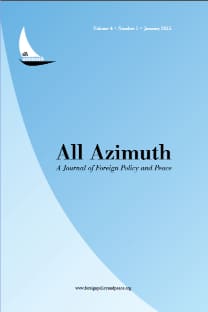The Geopolitical Origins of Turkish-American Relations: Revisiting the Cold War Years
The Geopolitical Origins of Turkish-American Relations: Revisiting the Cold War Years
Critical geopolitics provides ways of looking at the world and questioning the role of geopolitics in foreign policymaking processes, as opposed to accepting them as objective and natural. From this theoretical perspective, this article aims to apply critical geopolitics to the case of Turkish-American relations with respect to how the United States (US) viewed Turkey’s geography and how the Turkey-US alliance has been shaped by the foreign and security policies of the latter. The article argues that the alliance was a product of the US’ Cold War geopolitical discourse, wherein the US considered Turkey to be a strategic ally against Soviet expansion. Thereafter, the declaration of the Truman Doctrine on March 12, 1947, led to increased US military ties with Turkey and became the basis for Turkey’s inclusion in NATO in 1952. As a consequence, Turkey began to be defined as the anchor of NATO’s strategic southern flank and a barrier against the communist threat in the Middle East and the Mediterranean throughout the Cold War. Turkey has also been a major recipient of American military equipment and was a supplier of important military facilities for monitoring the Soviet Union. The paper also argues that while Turkey generally fits within the US’ geopolitical designs and that these two countries cooperated on numerous efforts during the Cold War, the Cyprus problem in that period revealed the limits of US geopolitical discourse.
Keywords:
US Foreign Policy, Cold War, Turkish-American relations, geopolitical discourse critical geopolitics,
___
- “Boğazlar Konusunda Amerika’nın Türkiye’ye 2 Kasım Notası.” In Belgelerle Türk-Amerikan Münasebetleri edited by Fahir Armaoğlu. Ankara: Türk Tarih Kurumu Basımevi, 1991.
- “Position on Question of the Turkish Straits-Exchange of Notes Between the Soviet Chargé d’affaires and Acting Secretary Acheson.” Department of State Bulletin 374, September 1, 1946.
- McGhee, George. The US-Turkish-NATO Middle East Connection: How the Truman Doctrine and Turkey’s NATO Entry Contained the Soviets. Houndmills, Basingstoke, Hampshire: Macmillan, 1990.
- NATO. “Final Communiqué.” Accessed April 1, 2010. http://www.nato.int/docu/comm/49-95/c510920a.htm.
- NATO. “NATO Enlargement.” Accessed April 1, 2010. http://www.nato.int/cps/en/natolive/topics_49212.htm.
- Nixon, Richard. “Address to the Nation on the War in Vietnam.” Accessed March 13, 2010. http://www.presidency. ucsb.edu/ws/?pid=2303
- Ó Tuathail, Gearóid, and John Agnew, eds. A Companion to Political Geography. Washington: Blackwell, 1998.
- Ó Tuathail Gearóid, and John Agnew, “Geopolitics and Discourse: Practical Geopolitical Reasoning in American Foreign Policy.” Political Geography 11 (1992): 190-204.
- Oran, Baskın. ed. Türk Dış Politikası: Kurtuluş Savaşından Bugüne Olgular, Belgeler, Yorumlar, Cilt 1: 1919-1980. Ankara: İletişim, 2001.
- Perle, Richard, and Michael J. McNamara, “US Security Assistance for Turkey and the Challenge of Aid for the Southern Flank.” NATO’s Sixteen Nations 32 (1987): 94-97.
- Rustow, Dankwart A. Turkey: America’s Forgotten Ally, New York: Council on Foreign Relations, 1987.
- Stearns, Monteagle. Entangled Allies: US Policy Toward Greece, Turkey and Cyprus. New York: Council on Foreign Relations, 1992.
- Stern, Laurence. The Wrong Horse: The Politics of Intervention and the Failure of the American Diplomacy, New York: Times Books, 1977.
- Tank, Pınar. “Dressing for the Occasion: Reconstructing Turkey’s Identity.” Southeast European and Black Sea Studies 6 (2006): 463-478.
- Truman, Harry. “The Truman Doctrine, Public Papers of the Presidents of the United States.” In The Geopolitics Reader, edited by Gearóid Ó Tuathail et.al. London: Routledge, 1998.
- United States. “Agreement Between the United States of America and Turkey Respecting Aid to Turkey.” United States Statutes at Large 62 (1948).
- US Congress House Committee on Foreign Affairs Hearings. Assistance to Greece and Turkey 80th Cong., 1st sess., 1947.
- US Department of State. FRUS: National Security Affairs; Foreign Economic Policy, 1950, vol. I. Washington, D.C.: USPGO, 1950.
- US Department of State. FRUS: Eastern Europe: the Soviet Union, vol. VI. Washington, D.C.: USGPO, 1946.
- US Department of State. FRUS: The Near East and Africa, 1946 vol. VII. Washington, D.C.: USGPO, 1946.
- US Department of State. FRUS: The Near East, South Asia, and Africa, 1949, vol. VI. Washington, DC: USGPO, 1949.
- US Department of State. United States Treaties and Other International Agreements, vol. 35, no. 6. Washington, DC: USGPO, 1983-1984.
- US Department of State. Policy Statement. Washington, DC: May 5, 1949.
- US Department of State. Department of State Bulletin 16 (January-March 1947).
- US House of Representatives and Senate, Legislation on Foreign Relations Through 1979: Current Legislation and Related Executive Orders: vol. 1. Washington, USGPO, 1980.
- Uslu, Nasuh. The Turkish-American Relationship between 1947 and 2003: A History of a Distinctive Alliance. New York: Nova Science Publishers Inc., 2003.
- Uslu, Nasuh. Türk-Amerikan İlişkilerinde Kıbrıs. Ankara: 21. Yüzyıl Yayınları, 2000.
- Uzgel, İlhan. “ABD ve NATO’yla İlişkiler.” In Türk Dış Politikası: Kurtuluş Savaşından Bugüne Olgular, Belgeler, Yorumlar, Cilt 1: 1919-1980, edited by Baskın Oran, Ankara: İletişim, 2001.
- Ülman, Haluk. Türk-Amerikan Diplomatik Münasebetleri: 1939-1947. Ankara: Sevinç, 1961.
- Wilson, Edwin C. Istanbul Press Reactions March 14 to Truman Speech. Ankara, March 14, 1947.
- Wohlstetter, Albert. “Meeting the Threat in the Persian Gulf.” Survey 25 (1981): 128-188.
- Yeşilbursa, Behçet Kemal. The Baghdad Pact: Anglo-American Defense Policies in the Middle East: 1950-1959. New York: Frank Kaas, 2005.
- Yılmaz, Şühnaz. “Challenging the Stereotypes: Turkish-American Relations in the Inter-War Era,” Middle Eastern Studies 42 (2006): 223-237.
- ISSN: 2146-7757
- Yayın Aralığı: Yılda 2 Sayı
- Başlangıç: 2012
- Yayıncı: Dış Politika ve Barış Araştırmaları Merkezi, İhsan Doğramacı Barış Vakfı
